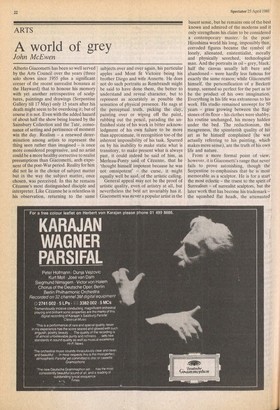ARTS
A world of grey
John McEwen
Alberto Giacometti has been so well served by the Arts Council over the years (three solo shows since 1955 plus a significant corner of the recent surrealist bonanza at the Hayward) that to honour his memory with yet another retrospective of sculptures, paintings and drawings (Serpentine Gallery till 17 May) only 15 years after his death might seem to be overdoing it; but of course it is not. Even with the added hazard of about half the show being loaned by the Sainsbury Collection and the Tate, consonance of setting and pertinence of moment win the day. Realism — a renewed determination among artists to represent the thing seen rather than imagined — is once more considered progressive, and no artist could be a more healthy corrective to realist presumptions than Giacometti, arch exponent of the post-War period. Reality for him did not lie in the choice of subject matter but in the way the subject matter, once chosen, was perceived. In this he remains Cezanne's most distinguished disciple and interpreter, Like Cezanne he is relentless in his observation, returning to the same subjects over and over again, his particular apples and Mont St Victoire being his brother Diego and wife Annette. He does not do such portraits as Rembrandt might be said to have done them, the better to understand and reveal character, but to represent as accurately as possible the sensation of physical presence. He nags at the perceptual truth, picking the clay, painting over or wiping off the paint, rubbing out the pencil, parading the unfinished state of his work in bitter acknowledgment of his own failure to be more than approximate, in recognition too of the inherent impossibility of his task. Spurred on by his inability to make static what is transitory, to make present what is always past, it could indeed be said of him, as Merleau-Ponty said of Cezanne, that he 'thought himself impotent because he was not omnipotent' — the curse, it might equally well be said, of the artistic calling. General appeal may not be the proof of artistic quality, even of artistry at all, but nevertheless the best art invariably has it. Giacometti was never a popular artist in the basest sense, but he remains one of the best known and admired of the moderns and it only strengthens his claim to be considered a contemporary master. In the postHiroshima world his long, impossibly thin, corroded figures became the symbol of lonely, alienated, existentialist, morally and physically scorched, technological man. And the portraits in oil — grey, black, half the canvas usually left bare and abandoned — were hardly less famous for exactly the same reason; while Giacometti himself, the personification of a Beckett tramp, seemed so perfect for the part as to be the product of his own imagination. Everything in his life was extraneous to his work. His studio remained unswept for 50 years — grass growing between the flagstones of its floor — his clothes were shabby, his routine unchanged, his money hidden under the bed. The reductionism, the meagreness, the spinsterish quality of his art as he himself complained (he was actually referring to his painting, which makes more sense), are the truth of his own life and nature.
From a more formal point of view, however, it is Giacometti's range that never fails to prove astonishing, though the Serpentine re-emphasises that he is most memorable as a sculptor. He is for a start the most eclectic — the truest to the spirit of Surrealism — of surrealist sculptors, but the later work that has become his trademark — the squashed flat heads, the attenuated figures large and small, particularly small — remains his most original contribution. Both types express the visual simplicity he strived to rediscover, the literal quality he so admired in the earliest art. The flattened heads succeed by making the obvious but never so starkly demonstrated point that faces seen from the front give no indication of what they will look like from the side. His meagre figures make spaces of bases and thin air speak volumes. In both he extends the surface expressiveness and illusionary possibilities of sculpture by incorporating some of the methods and lessons of the much richer visual language of painting. The extravagantly fingered clay, which makes such a delicate play of the light when cast as bronze, can be understood, especially in close up, as the equivalent of the self-assertive brushstroke. The base as Space dotted with hurrying figures is equally the base as canvas. His pictorial work is not the imaginative match of this. At Thomas Gibson Fine Art (till I May) eight specimens boost the paintings and drawings at the Serpentine. They include a rare portrait In profile, an angle that utterly defeats his unceasing attempt to convey volume. Even the finest of his portraits, however, fail to disturb the justified preconception that he was a sculptor who painted, rather than the reverse. A Giacometti Portrait by James Lord (Faber Paperbacks, £2.25), interestingly documenting the experience of sitting to the artist, has been reissued and provides a timely complement to the shows.



































 Previous page
Previous page